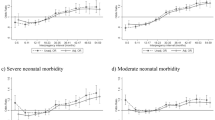Abstract
We conducted a retrospective cohort study of 9,552 women experiencing their second delivery between 2014 and 2016 at the International Peace Maternity and Child Health Hospital to investigate the association between the interpregnancy interval (IPI) and adverse perinatal outcomes. With the 12–23-mon IPI as the reference category, logistic regression analyzes were used to examine associations between different IPIs (<12, 12–23, 24–59, 60–119, and ≥120 mon) and perinatal outcomes (gestational diabetes mellitus, premature membrane rupture, gestational hypertension, preterm birth, low birth weight, and macrosomia). Compared with the 12–23-mon IPI category, women with longer IPIs had a higher risk of adverse perinatal outcomes, and those with an IPI ≥120 mon had the highest risk of gestational diabetes mellitus and premature membrane rupture (adjusted odds ratio (OR) 1.76, 95% confidence interval (CI) 1.32–2.35 and adjusted OR 2.03, 95% CI 1.53–2.67, respectively). These results indicate that a longer IPI is associated with a higher risk of adverse perinatal outcomes and an IPI of ≥120 mon appears to be independently associated with a higher risk of gestational diabetes mellitus and premature membrane rupture.
Similar content being viewed by others
References
Al-Rowaily, M.A., and Abolfotouh, M.A. (2010). Predictors of gestational diabetes mellitus in a highparity community in Saudi Arabia. East Mediterr Health J 16, 636–641.
Bigelow, C.A., and Bryant, A.S. (2015). Short interpregnancy intervals: An evidence-based guide for clinicians. Obstetrical Gynecol Survey 70, 458–464.
Cecatti, J.G., Correa-Silva, E.P.B., Milanez, H., Morais, S.S., and Souza, J. P. (2008). The associations between inter-pregnancy interval and maternal and neonatal outcomes in Brazil. Matern Child Health J 12, 275–281.
Conde-Agudelo, A., and Belizán, J.M. (2000). Maternal morbidity and mortality associated with interpregnancy interval: Cross sectional study. BMJ 321, 1255–1259.
Conde-Agudelo, A., Belizán, J.M., Norton, M.H., and Rosas-Bermúdez, A. (2005). Effect of the interpregnancy interval on perinatal outcomes in Latin America. Obstetrics Gynecol 106, 359–366.
Conde-Agudelo, A., Rosas-Bermúdez, A., and Kafury-Goeta, A.C. (2006). Birth spacing and risk of adverse perinatal outcomes: A meta-analysis. JAMA 295, 1809–1823.
DeFranco, E.A., Seske, L.M., Greenberg, J.M., and Muglia, L.J. (2015). Influence of interpregnancy interval on neonatal morbidity. Am J Obstetrics Gynecol 212, 386.e1–386.e9.
Hafner, E., Schuchter, K., Metzenbauer, M., and Philipp, K. (2000). Uterine artery Doppler perfusion in the first and second pregnancies. Ultrasound Obstet Gynecol 16, 625–629.
Hanley, G.E., Hutcheon, J.A., Kinniburgh, B.A., and Lee, L. (2017). Interpregnancy interval and adverse pregnancy outcomes. Obstetrics Gynecol 129, 408–415.
Hesketh, T., Zhou, X., and Wang, Y. (2015). The end of the one-child policy: Lasting implications for China. JAMA 314, 2619–2620.
Kangatharan, C., Labram, S., and Bhattacharya, S. (2016). Interpregnancy interval following miscarriage and adverse pregnancy outcomes: Systematic review and meta-analysis. Hum Reprod Update 18, 221–231.
Mignini, L.E., Carroli, G., Betran, A.P., Fescina, R., Cuesta, C., Campodonico, L., De Mucio, B., and Khan, K.S. (2016). Interpregnancy interval and perinatal outcomes across Latin America from 1990 to 2009: A large multi-country study. BJOG-Int J Obstet Gy 123, 730–737.
Mittendorf, R., Lain, K.Y., Williams, M.A., and Walker, C.K. (1996). Preeclampsia: A nested, case-control study of risk factors and their interactions. J Reprod Med, 41, 491–496.
Qin, C., Mi, C., Xia, A., Chen, W.T., Chen, C., Li, Y., Li, Y., Bai, W., and Tang, S. (2017). A first look at the effects of long inter-pregnancy interval and advanced maternal age on perinatal outcomes: A retrospective cohort study. Birth 44, 230–237.
Shachar, B.Z., Mayo, J.A., Lyell, D.J., Baer, R.J., Jeliffe-Pawlowski, L.L., Stevenson, D.K., and Shaw, G.M. (2016). Interpregnancy interval after live birth or pregnancy termination and estimated risk of preterm birth: A retrospective cohort study. BJOG-Int J Obstet Gy 123, 2009–2017.
Shah, P.S. (2010). Parity and low birth weight and preterm birth: A systematic review and meta-analyses. Acta Obstet Gynecol Scand 89, 862–875.
Sholapurkar, S.L. (2010). Is there an ideal interpregnancy interval after a live birth, miscarriage or other adverse pregnancy outcomes? J Obstetrics Gynaecol 30, 107–110.
Shults, R.A., Arndt, V., Olshan, A.F., Martin, C.F., and Royce, R.A. (1999). Effects of short interpregnancy intervals on small-for-gestational age and preterm births. Epidemiology 10, 250–254.
Stamilio, D.M., DeFranco, E., Paré, E., Odibo, A.O., Peipert, J.F., Allsworth, J.E., Stevens, E., and Macones, G.A. (2007). Short interpregnancy interval: Risk of uterine rupture and complications of vaginal birth after cesarean delivery. Obstetrics Gynecol 110, 1075–1082.
Waldenström, U., Cnattingius, S., Norman, M., and Schytt, E. (2015). Advanced maternal age and stillbirth risk in nulliparous and parous women. Obstetrics Gynecol 126, 355–362.
Wang, C. (2012). History of the Chinese Family Planning program: 1970–2010. Contraception 85, 563–569.
Wendt, A., Gibbs, C.M., Peters, S., and Hogue, C.J. (2012). Impact of increasing inter-pregnancy interval on maternal and infant health. Paediatric Perinatal Epidemiol 26, 239–258.
Zeng, Y., and Hesketh, T. (2016). The effects of China’s universal two-child policy. Lancet 388, 1930–1938.
Zhu, B.P., Rolfs, R.T., Nangle, B.E., and Horan, J.M. (1999). Effect of the interval between pregnancies on perinatal outcomes. N Engl J Med 340, 589–594.
Acknowledgements
This work was supported by the Major Program of National Natural Science Foundation of China (81490742, 31471405, 81771593 and 81671456), the National Key Research and Development Program of China (2017YFC1001303 and 2018YFC1003200), the International Cooperation Project of China and Canada NSFC (81661128010), the Interdisciplinary Key Program of Shanghai Jiao Tong University (YG2014ZD08), and the Shen Kang Three-Year Action Plan (16CR3003A).
Author information
Authors and Affiliations
Corresponding author
Ethics declarations
Compliance and ethics The author(s) declare that they have no conflict of interest. The study was approved by the Ethics Committee of the International Peace Maternity and Child Health Hospital, School of Medicine, Shanghai Jiao Tong University. Written informed consent was obtained from all participants.
Rights and permissions
About this article
Cite this article
Lin, J., Liu, H., Wu, DD. et al. Long interpregnancy interval and adverse perinatal outcomes: A retrospective cohort study. Sci. China Life Sci. 63, 898–904 (2020). https://doi.org/10.1007/s11427-018-9593-8
Received:
Accepted:
Published:
Issue Date:
DOI: https://doi.org/10.1007/s11427-018-9593-8




